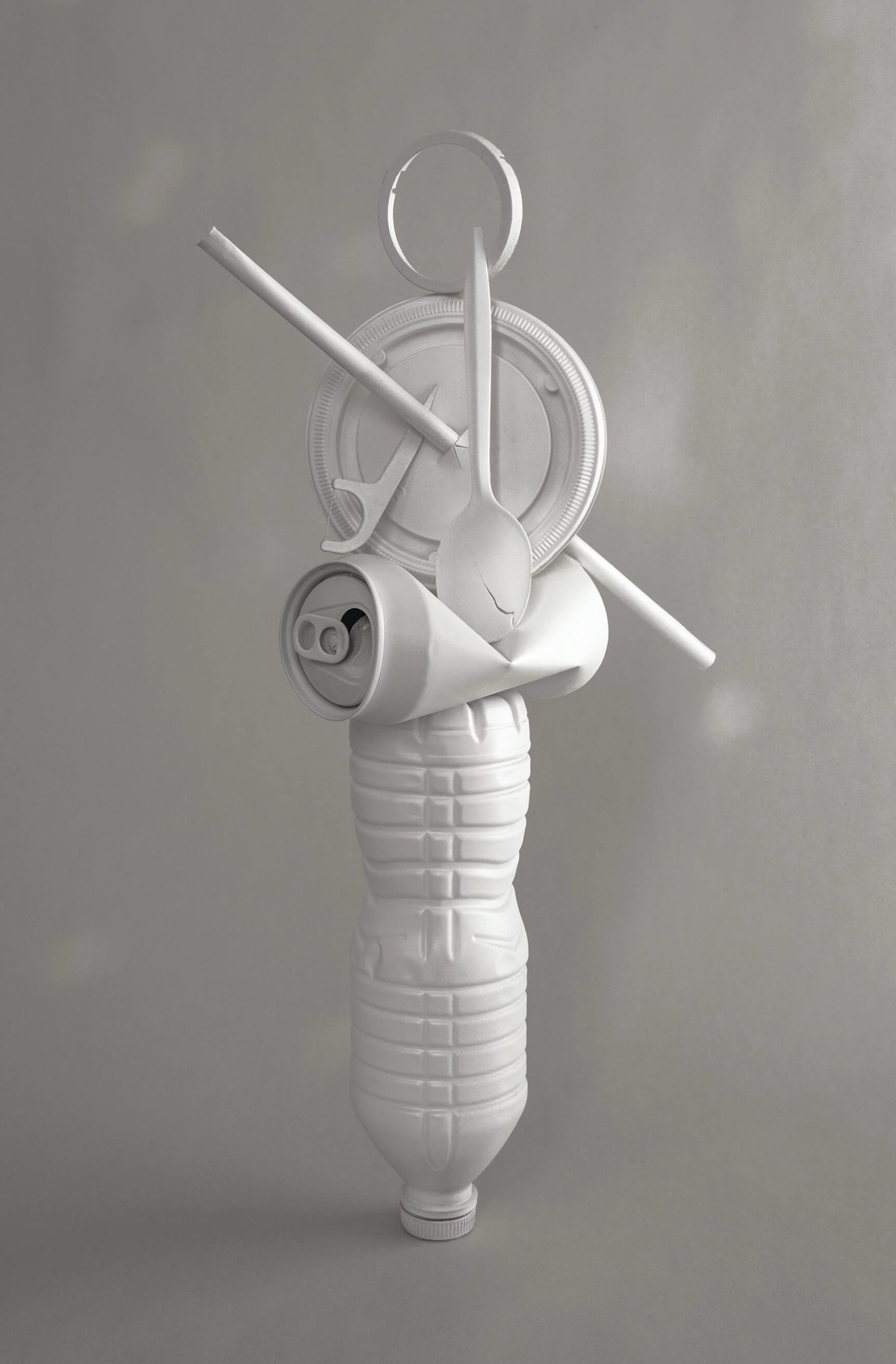Every time I throw something away, I take its photograph. I’ve been doing this since February 2016. I post the images of each day’s trash to Instagram. Almost six years later, the account comprises the most detailed and consistent diary I have ever kept.
The ritual began in response to a sullen moment. Heading to work earlier than usual one morning, I stopped at a café, ordered to stay, and took a seat. Clear winter light came through the large window, and I inclined my head to it—into the luxury of a breakfast out alone. A few minutes later, the cashier, who turned out to also be the cook, set down my meal of two eggs and toast in a plastic clamshell, accompanied by plastic utensils sheathed in plastic film. I ate quickly and without enjoyment. Then I closed the utensils now mingled with the DNA in my saliva inside the yolk-streaked container and shoved the mess through the hutch over the restaurant’s waste bins.
When I take out my phone to photograph my trash, a common response is to ask if I am trying to “go zero waste.” I reply, no, I am trying to see my waste.
Making trash, especially plastic trash, set a low hum of guilt and anxiety coursing through me. These items I had not wanted, and used for mere minutes—or not at all, in the case of the spoon that came bundled with the fork and knife—could remain in the environment for hundreds of years. The asymmetry brought a familiar sense of abjection. The breakfast was to sustain me through the desk work that constituted my paid labor, employment that in turn was to fund my “real work” as a poet. Yet from another perspective, it seemed more accurate to say that my life’s work was trash-making. I would die, everyone I’d ever known would die, and this clamshell and utensil set would still be there somewhere on Earth. None of my poetry would have such an enduring legacy.
What specifically would become of my discards? I had only a vague sense. New Yorkers live among trash, accustomed to stepping over litter and around low mountain ranges of garbage bags and junk items at the curb. But the contents of that trash are already moving away from those who generated it. Working often at night and in the early hours, thousands of people—employees of the Department of Sanitation, commercial carters, informal pickers and canners—orchestrate the first step in the fantastic, disappearing our mingled wastes. Thanks to them, our responsibility for waste disposal seems to end at the proper bin. Where these objects go, who handles them, or what happens to them does not feel like our concern. The very language we use to talk about trash—“to throw away,” “to toss out”—gestures to an unimportant and ill-defined over there with imperious affect.
When I arrived at work, I opened a word document and typed out a list of the items I’d just released into the waste stream: “Plastic clamshell, plastic fork, knife, and spoon, thin paper napkin, plastic film wrapping.” I kept a written record like this for several days. My discards tended to be similar. I wrote, “Paper filter and coffee grounds,” “Q-tip with earwax,” “apple core,” “envelope,” “floss,” one day, and I wrote some variation of the same words the next. In reiteration, language belied the unique material presence of each trashed object. So I turned to photography.
The photos are not precious. I take them quickly, on my phone, in situ. Many feature my hand. I include anything that I personally direct to trash, recycling, or compost. [1] I do not include excrement or toilet paper, which is directed to wastewater management, rather than handled as municipal solid waste. I photograph objects that I have used but someone else will throw away (e.g., scraps on a restaurant plate), as well as objects that have been used primarily by others but I throw away (e.g., catering platters at work events). If I have shared something that ends its useful life in someone else’s hands, I do not insist that they wait for me to discard it (e.g., if my partner squeezes out the last of the toothpaste one night), but I endeavor not to use this as a loophole.
When someone learns about my documentation practice, it is typically because I have taken out my phone to photograph an unconventional subject—say, the plastic wine cup at the end of a party. A common response is to ask if I am trying to “go zero waste.” I reply, no, I am trying to see my waste. I am trying to see the individual items that constitute my life’s trash, to remember them in a kind of elegy, and by posting to Instagram, to let them stand for my living.
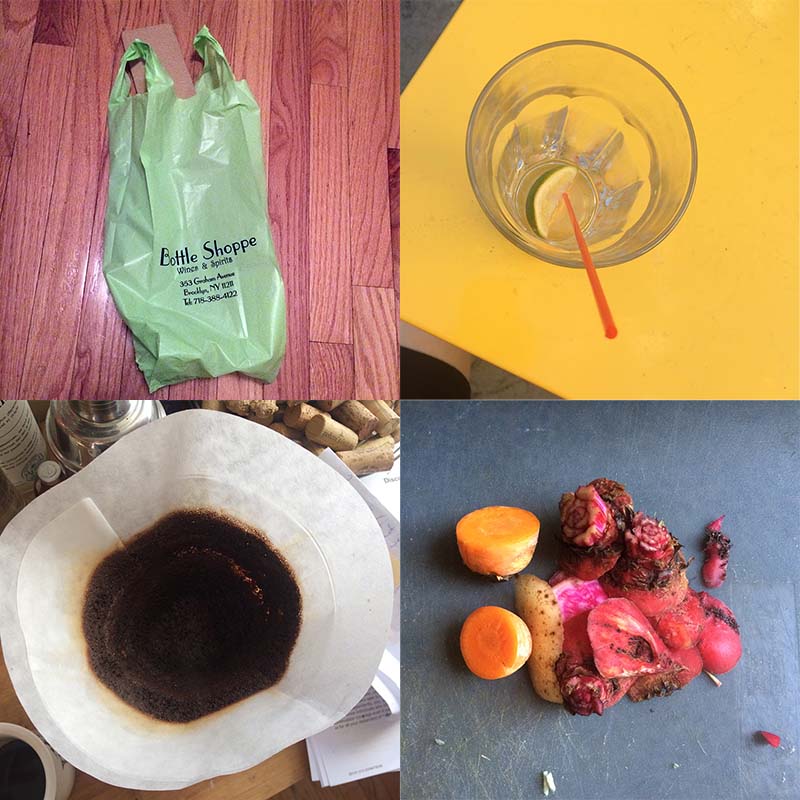
I Keep My Trash in a Jar
Popular discourse around trash—like bodyweight—runs overwhelmingly along lines of management. The framing assumption is that one should reduce. This is nowhere more evident than in a term like “zero waste.” As described in Robin Murray’s 2002 book by the same name, zero waste proposes replacing traditional waste management with a holistic approach that “encompasses producer responsibility, ecodesign, waste reduction, reuse and recycling, all within a single framework.” Along with preventing waste before it’s made (called “source reduction”), the key idea is to conceptually reframe trash as a resource, to be mined, rather than something useless, to be disposed. This would require, among other things, changing the physical composition of commodities, so that products are designed and manufactured with their reincarnation in mind.
The movement by which a radical idea is swept up into a feel-good consumer trend is as familiar an arc as the turning of the seasons.
Needless to say, wide-reaching changes would be needed to achieve zero waste. If enacted, its principles would have major implications across policy, industry, and infrastructure. Still, municipalities around the world have adopted the term to describe targets to reduce dependence on landfill and incineration. For instance, the OneNYC plan Mayor Bill de Blasio’s office released in 2015 proposed several initiatives under the banner of zero waste. These included the plastic bag ban (implemented in 2020), a proposal to overhaul privately run commercial waste carting, the expansion of the New York City Department of Sanitation organics program, bringing recycling programs to NYCHA housing, and diverting truck traffic away from the low-income neighborhoods where transfer stations are concentrated, which environmental justice advocates have long demanded.
When friends ask if I am trying to go zero waste, they are not referring to such work. Despite its roots in systems thinking, “zero waste” has also come to denote consumer choices by which an individual cuts their trash down to almost nothing. This sense of the term was popularized by Béa Johnson, a French-American mother of two based in Mill Valley, California, who managed to reduce her family’s annual trash to a single pint-sized jar in 2008. In 2009, she began writing about her efforts in a blog. “I have put my family on a waste diet for the past twelve months,” Johnson noted in her debut entry. “Analyzing whatever comes in contact with the bottom of our one home trash can and slowly trying to get it as close to zero waste as possible. . . . You’ll see what I am talking about.”
What follows is a mix of documentary, practical advice, and reflection. Johnson modifies the traditional three ‘R’s to include composting as “rot.” But her most important lesson is another R, “refuse.” By far the most effective way to eliminate one’s waste is to not come into possession of disposable items in the first place. An early post-Christmas entry offers a list of items trashed, replete with strategies to eliminate this source in the future: “Wrappers of cough lozenges. Note to self: find a recipe for honey candy for the kids’ coughs” and “Lego packaging: the boys each received a brand new set from grandma, the box and baggies (#5) seemed recyclable but the sticker sheets and plastic accessory holder did not. Note to self: Call recycling center and ask if the sticker sheets (and USPS stamp sheets) are recyclable.” In 2013 Johnson collected her tips in a guidebook, The Zero Waste Home, now an Amazon bestseller translated into twenty-eight languages. In 2020 she lived with her husband in an airstream trailer, touring the country to preach zero waste.
Today, there are any number of zero-waste lifestyle advocates. Most follow Johnson’s basic model, documenting their “zero-waste journey” online and offering advice to others looking to start theirs. Several also sell waste-saving products, such as Lauren Singer, founder of the retailer Package Free. Ironically, the term “zero waste” now evokes a coterie of consumer items such as the cotton tote bag, the reusable water bottle, the thermos, the metal straw, and reusable food-wrap. Like “natural,” zero waste has no standardized regulated definition. Brands also apply it to products that are recyclable or compostable or come in packaging made from post-consumer recycled materials. When I put the term in a search engine, the first hit is an ad for “zero-waste mascara” that I can have shipped to my door.
The movement by which a radical idea is swept up into a feel-good consumer trend is as familiar an arc as the turning of the seasons. In the best light, attempting a zero-waste lifestyle challenges the consumer to evaluate her true needs. At worst, zero waste is a fantasy of personal innocence that contributes to a broader social fantasy of sustainable consumption, in which what is ultimately upheld is an extractive relationship to the earth and others’ labor. (It should come as no surprise that the vast majority of zero-waste influencers are middle-class white ladies, a demographic to which I also belong.) What a zero waster cannot do is meaningfully intervene in the ecological and public health impacts associated with trash. When post-consumer trash accounts for only a tiny fraction of the total waste stream in the United States—relative to construction waste and industrial waste—the effect of individual choice is negligible.
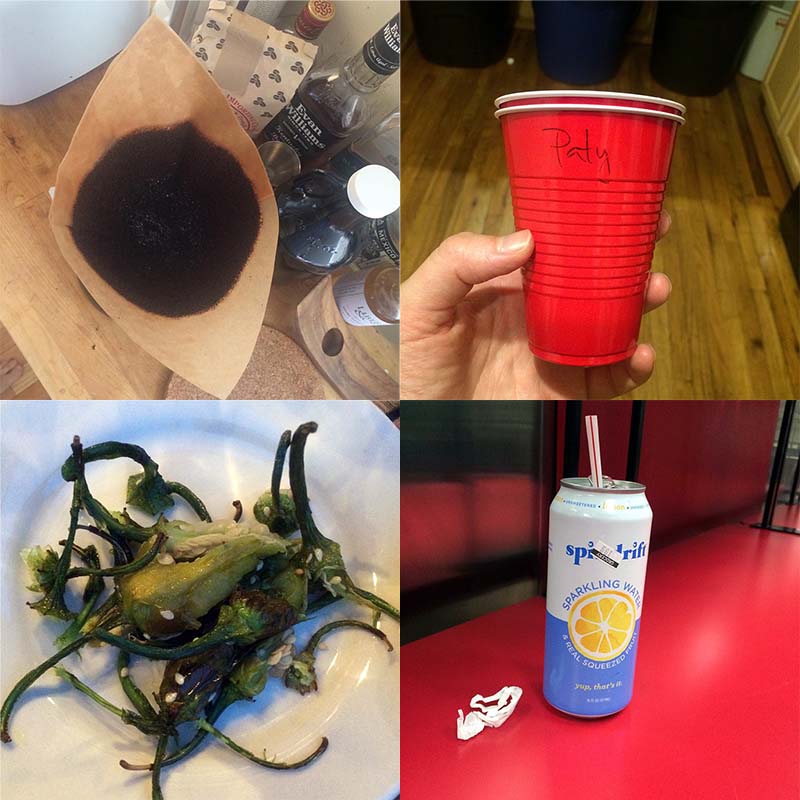
Every Litter Bit Hurts
The fixation on individual habits is not just a matter of narcissism. It is part of the cultural ethos bred in tandem with the consumer society born in the postwar boom. The mid-twentieth century saw the rise of a tremendous variety of new commodities and new habits in material culture. Until the 1950s, almost all containers were refillable or returnable—think the milkman or local soda works—moving “two ways,” from the producer to the consumer and back. “One-way” packaging, which emerged around this time, uniquely transformed the volume and character of discards. It expanded the possibilities for product distribution, introduced new surfaces for marketing, and acculturated the public to a new type of object: one designed to be trashed. Such pedestrian items as the pull-top drinking can, plastic and foam cups, ketchup packets, bubble wrap, even the trash bag are among the sundry one-use products to make their market debuts in the 1950s and 1960s. The applications of plastics became ever more diverse throughout the 1970s. The first polyethylene terephthalate (PET) bottles for carbonated beverages began to appear in stores in the mid-1970s, ironically in the midst of an oil crisis. In 2018, the most recent year for which EPA data is available, packaging and containers accounted for 28 percent of municipal solid waste nationwide, the largest portion by product type.
As single-use packages proliferated, the same industries that developed these products worked to shape waste policy. Heather Rogers’s mid-2000s book Gone Tomorrow: The Hidden Life of Garbage offers a detailed history of this period, giving particular attention to the tactics packaging interest groups used to resist legislation. A ban on single-use beverage containers was first proposed in Vermont in 1953, in response to the concerns of dairy farmers whose cows were getting sick after ingesting broken glass from bottles thrown to the side of the road. The law passed but expired after four years, and opposition from the beer industry successfully blocked its renewal. In the years to come, interest groups across the packaging, bottling, and beverage industries countered state and local measures across the country, from restrictions on certain types of packaging to mandatory deposit systems. Even the “bottle bills” requiring deposits now in place in ten states were hard-won and limited in scope. Note that the five- and ten-cent deposit rates have held flat since they were first passed, most in the 1970s and 1980s.
Industry leaders also worked to influence public opinion. Particularly significant was the work of Keep America Beautiful (KAB), a nonprofit founded in 1953, the same year as Vermont’s disposal ban, by the American Can Company and the Owens-Illinois Glass Company, and later joined by powerful entities such as Coca-Cola, Dixie Cup, and the National Manufacturers’ Association. In its early years, KAB sponsored community-oriented beautification programs to remove debris from parks and highways. More ambitiously, it partnered with the Ad Council to launch nationwide campaigns against litter. An early series of TV and print ads feature Susan Spotless, a blond tot in a white sailor suit who dutifully picks up trash her father has dropped and places it in a public receptacle. “Daddy, every litter bit hurts!” she scolds. KAB’s most lauded (and also most infamous) ad debuted about a decade later, in 1971. Actor Iron Eyes Cody, in a costume inspired by Plains Indian dress, canoes down a river revealed to be strewn with trash. He climbs a bank and reaches a road, where a driver tosses refuse out of the window, which splatters at Cody’s feet. “Some people have a deep, abiding respect for the natural beauty that was once this country. And some people don’t,” the narrator laments. A single tear rolls down Cody’s cheek as the narrator continues, “People start pollution. People can stop it.”
These ads are not likely to resonate with the contemporary viewer. Susan Spotless’s vision of cleanliness has little to do with the toxic pollution trash now represents, and her pouty finger-wagging offers no solution. The implication that the suffering inflicted on native peoples is a question of “beauty” and that settler-colonialists’ abuse of their land is characterized by littering is outrageously offensive. (To make matters worse, in 1996, it was revealed that Iron Eyes Cody, who claimed to be Cherokee and Cree, in fact had no native heritage.) However, their messages hold. Contemporary discourse around trash, from the three Rs to zero waste, echoes Susan Spotless’s do-your-part duty. Much the same is true of legislation. As regulatory laws were blocked, fines for littering became commonplace. In this bait-and-switch, pollution is presented as the result of post-consumer behavior, and its solution is responsible individual waste hygiene. As Rogers notes, “KAB wanted to turn any stirrings of environmental awareness away from industry’s massive and supertoxic destruction of the natural world, telescoping ecological disaster down to the eyesore of litter and singling out the real villain: the notorious ‘litterbug.’”
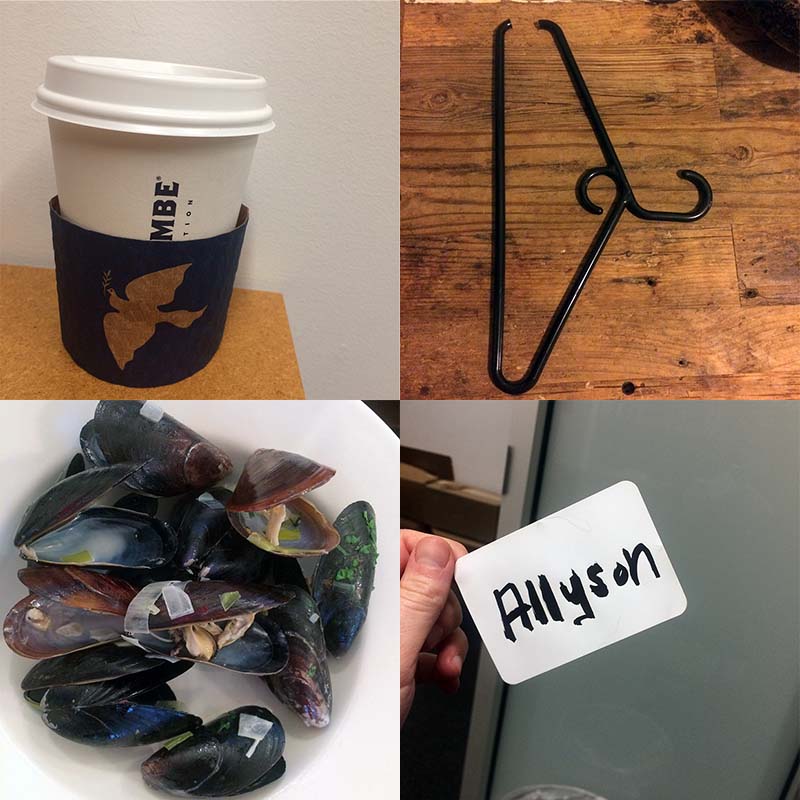
Reduce, Reuse, Wishcycle
The focus on individual behavior dovetails elegantly with the advent of recycling. Recycling is often lauded as a victory for grassroots environmentalists, as the municipal collection programs we know today grew out of voluntary community-based initiatives in the late 1960s and 1970s. Samantha MacBride challenges this narrative in her 2011 book Recycling Reconsidered, which questions whether recycling does any environmental good at all. MacBride argues that the popularity of recycling has masked its many failures, allowing big manufacturers to resist more taxing waste policies. A case in point is New York City’s municipal collections program. In the 1970s, a citizens’ association, the Environmental Action Coalition (EAC), successfully launched local recycling centers across the city, and later partnered with the Department of Sanitation to establish its curbside program, which began in 1986 and became mandatory in 1989. Yet the EAC’s funding division board included executives from companies including Coca-Cola, Seven-Up, and the Aluminum Association. McBride’s archival research reveals that EAC leaders pushed for expanded recycling while speaking against the proposals for “fees, taxes, and other surcharges to force costs and material back onto producers” put forward by the city’s EPA. As recycling programs expanded across the country, so did the annual tonnage of municipal wastes, a trend that continues to the present day.
The problem with post-consumer recycling is that it places responsibility firmly in the hands of the consumer and the state, while absolving companies of all responsibility.
This points to a larger problem with post-consumer recycling, which is that it places responsibility firmly in the hands of the consumer and the state, while absolving companies of all responsibility. More insidiously, recycling locates the environmental impact of consumer goods in a single decision made when an object passes from the realm of the useful to the disposable. The limited focus engenders a positive feeling around simply putting waste in the recycling bin. Manufacturers have preyed on this, against the actual practicability of recycling, in which sorting is only the first step. The chasing arrows emblem, that environmental ouroboros, is stamped on products ostensibly to aid correct handling, but these marks obfuscate. The numbering system codes all objects including those that cannot be recycled within the chasing arrows symbol. Like the mythical “away” into which trash is disappeared, the arrows introduce a possibility, that what you dispose of might find a new life. This has practical problems, leading people to “wishcycle,” that is, throw in with one’s recyclables objects that cannot be reprocessed.
In truth, there’s no guarantee that anything you put in the right bin will be turned into new material, let alone that a manufacturer will buy that material to create something new. The process itself can be damaging, involving shipping, low-paid and dangerous labor, and toxicity. If some recycling is sorted and processed locally or domestically, as much or more is shipped abroad, often illegally. Consider the sensational images that periodically circulate the news and social media. A rosy-cheeked toddler sits at the foot of a technoscrap mountain in Guiyu, China, sometimes called the “e-waste capital of the world”; teens burn circuit boards against a landscape of debris and heavy smoke at Agbogbloshie, the scrapyard in Accra, Ghana, also sometimes called the “e-waste capital of the world”; an older man faces a wall of bottles stretching above him to every corner of the frame at an unnamed Malaysian plant. All of these show resource recovery in action.
This is not to say that recycling is not worthwhile. It can be, especially for certain materials, such as metals. Yet whatever the environmental outcomes of recycling, its major influence has been in shaping the cultural imagination about discards. After all, what the chasing arrows draw is a loop, a reassuring stamp against entropy.
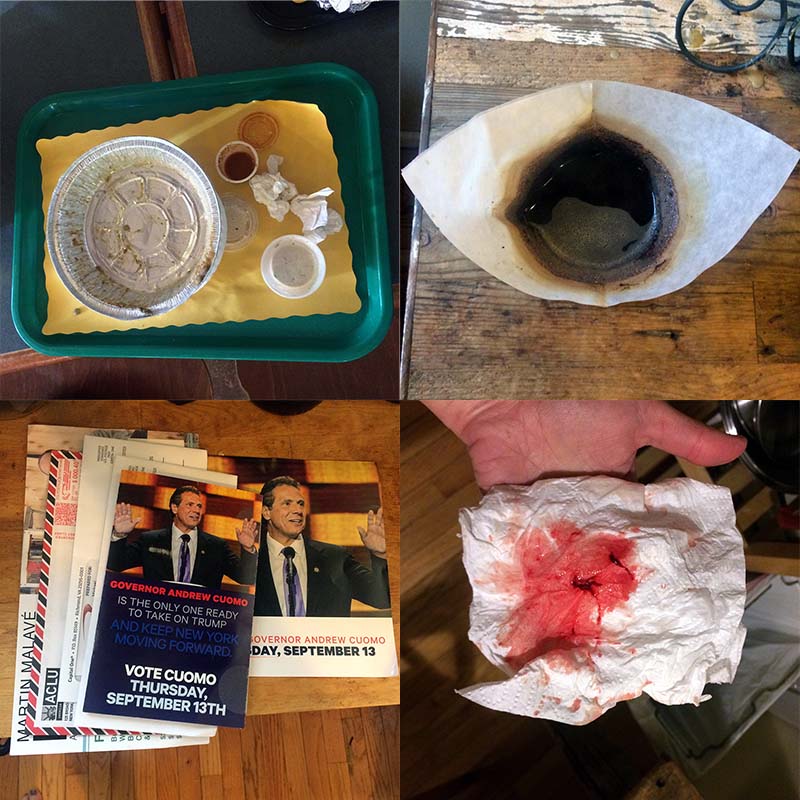
The Heap of Individuals
Garbage is defined as such only by the act of throwing away. The objects that enter the waste stream have no inherent properties, save for a history of having been discarded. Greg Kennedy, in his book An Ontology of Trash, proposes that the contradiction between obliteration and endurance is the defining property of garbage. He explains:
[Trash] is supposed to lack whatever legitimates the presence of an object in our world. In short, the disposable should not be. Yet obviously, and worrisomely, it is, and so remains, usually for a great many years. Ontologically, no other subject is quite so tantalizing as this very odd being that simultaneously resists and includes its nonbeing.
To consider that garbage comes into being through annihilation is more than a philosophical trick. It reveals the ultimate “zero” with which trash is connected, that of having been absented of value. If I am attending to my waste, it is assumed that I must be trying to reduce it. Trash in itself is not thought to possess any other possible worth. Framed only as a problem to solve, the myriad objects we come to possess and then toss out are written over into abstraction: given in weights, material categories, and levels of toxicity, or else imagined as a symbol, morally charged.
Robin Nagle, resident anthropologist at the New York City Department of Sanitation, astutely interprets garbage as a function of the pace of our daily lives. “We depend on our ability to move fast,” she writes, “and so assume the briefest relationships with coffee cups, shopping bags, packaging of all kinds—encumbrances we must shed quickly so that we can maintain what I call our average necessary quotidian velocity.” What sets the pace of this quotidian velocity is, of course, work. The ease that consumerism promises has always been in service of productivity; the associated trash-making is one more expression of capitalism’s purchase on our time. Bereft of its use value and exchange value alike, the trashed commodity is a recalcitrant chunk of matter that speaks to what this economic system ultimately offers, to the earth and in our connections to one another.
The ease that consumerism promises has always been in service of productivity; the associated trash-making is one more expression of capitalism’s purchase on our time.
If the goal of my photographs is to represent the footprint of my waste, it fails for the same reasons a zero-waste lifestyle fails. I can never see the totality of my trash, because it’s bound up with that of others. I may photograph less food waste when I go out to a restaurant than when I cook at home, but it’s only because someone else is cooking, and tossing away the scraps. Still, I continue the practice, in part because I’m curious about what I now see in the images. Looking at my trash, I have also come to understand that waste is much more than a problem. The discrete and diverse objects that comprise trash contain the story of our desires, our material relations to the planet, and to one another.
Today, I would still be disappointed if my food arrived in a clamshell container in a sit-down restaurant, but the object would not fill me with abjection. I see now that it bears the trace of interlocking and wide-reaching experiences, all bound up with labor. My brief relationship with that object was made possible by the efforts of the man who rang me up, cooked my eggs, and brought them to me; of those who delivered it to the store, perhaps driving it across the country in a truck, unloading it at a shipping dock, ferrying it across the Pacific; who manufactured it; who drilled and refined the petroleum long underground; who will later bring the café’s trash to the curb; will drive it to a transfer station; will handle it further down the waste stream.
Neither the plastic clamshell nor an image of it can reveal the specifics of its history or future. However, on Instagram, my own life is represented as a similar specter: one among many who must have handled this object. The photographs invite me to imagine the many people, places, and materials with which this object has intersected, or will. It’s insufficient to say that “people” cause pollution. Or that “people,” just a heap of individuals, can solve it. But it is exactly such a collective that the wasted items bind together.
[1] The terms “trash,” “garbage,” “waste,” “refuse,” have discrete meanings in different contexts, especially in waste management, but I am using them in the colloquial sense, i.e., interchangeably.
